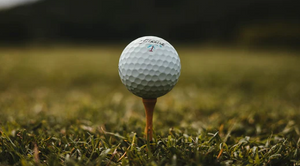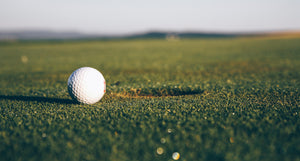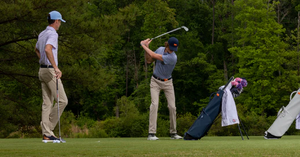Do Golf Balls Make a Difference?
If you've ever been to a golf shop, you know many kinds of golf balls exist. It may even have felt overwhelming. How do you know which one to pick, and does it really make a difference? Below, we break down all the different types of golf balls, so you can find the one that's best for your success.
How Golf Balls Are Different
Believe it or not, there are different kinds of golf balls - and they can have a significant impact on your game. Choosing the correct type of ball for the course and your skill level is essential - if you’d like to improve, that is. Let’s talk through a few factors you should look out for:
Number of Layers
Many people are surprised to learn that golf balls aren't made of a single material. Like baseballs or bowling balls, golf balls feature numerous layers of varying materials. If you cut a golf ball down the middle, the inside would look a lot like a diagram of the Earth's core!
All golf balls have a small ball - or core - in their center, much like the pit of a peach. Simpler golf balls have only one or two layers of material surrounding the core. These are best for beginners and casual golfers. They're also the least expensive option! There are more complex balls that have multiple layers - these tend to be more costly and require special considerations when playing. Players usually only use multi-layer balls at the semi-professional or professional level. If you’re not there yet, stick with the casual-level option. We’ve all got to start somewhere!
Compression Level
When you look at the packaging on golf balls, you'll usually see a compression rating or number. Compression refers to the core of the ball and the pressure the layers of the golf ball are experiencing. Professionals must account for compression when planning their shots and usually opt for balls with 100+ compression.
Casual golfers and high handicap players can use higher compression balls, but they can also get by just fine at a lower compression rate. High-compression balls are usually more expensive and are only worth the cost to professional players.
Number of Dimples
Golf balls aren't smooth on the surface - they're covered in hundreds of tiny indents called dimples. Far more than an aesthetic, many people don't realize how vital dimples are. Believe it or not, the number of dimples can significantly impact your shots.
Dimples increase the surface area and alter how wind forces interact with the ball, creating distance and spin. The more dimples, the faster and farther a ball can travel. Experienced golfers tend to prefer higher dimple counts - 500 is the max. Players still mastering spin will often opt for lower dimple counts of around 300.
Hardness
If you've ever been hit by a flying golf ball, you can attest that all golf balls feel hard. But when it comes to picking a ball, there are differences in hardness. The harder the ball, the farther it can travel in one direction. A softer ball will have a better spin and is usually better for tricky shots, and it also feels better when hit with the club.
Professional golfers often play with soft and hard balls, depending on the course and conditions. Players with higher handicaps tend to prefer a softer ball.
Type of Coating
When it comes to ball coatings - sometimes referred to as cover - there are two options: surlyn and urethane. Surlyn coatings reduce spin and are best for new golfers still mastering the basics. Urethane increases the spin on a ball and is better for experienced golfers who know how to utilize spin.
Do Golf Balls Make a Difference for Beginners?
The short answer is: not really. Many people make the mistake of thinking they need top-of-the-line golf gear to improve their game. It can be tempting to spring for a higher-end ball with many layers and dimples, a urethane coating, and a high compression level. But here’s the truth: it's not worth the money if you don't know how to use those features properly.
In fact, starting with a high-end ball can hamper the learning process. Beginners should focus on mastering their stance and angles; they're in for a hard time if they play with a ball with a high spin. It's best to start with the basics. Beginners should look for a soft, single, or double-layer ball with a surlyn coating and a dimple count of around 300.
Do Golf Balls Matter for High Handicappers?
Golfers who play with a high handicap should stick to a softer ball that has a low spin and low compression. Even if you've been golfing for a while, a beginner ball will suit your needs just fine. Cost should be one of the most critical factors for high handicap players. You're likely to go through balls quickly, and beginner ones are much less expensive. It's better to spend a few bucks for a handful of one-dollar balls than twenty dollars for the same amount!
Do Golf Balls Matter for Mid-to-Low Handicappers?
Golfers who play with a middle or low handicap may be more particular about their ball type. At this level, you've mastered many skills you'd need for higher-end balls. You probably don't have to buy balls often, so investing in more expensive styles may be worth it.
Mid and low-handicap players may want a multi-layer ball with 400-500 dimples and a middle-to-high compression rate - although 100+ compression is probably overkill. These players could use urethane coating if they want, but they would still do well with surlyn coating.
Do Golf Balls Make a Difference for Seniors?
It depends! For many older players, hardness is one of the most critical factors for a successful round. Senior players may prefer a softer ball, even if they have a lot of experience and a low handicap. There are two reasons for this. First, softer balls feel better when you hit them. Hitting a harder ball can cause reverberation to travel up the club and into your arms, which can be hard on older joints. The second reason is that softer balls don't travel as far, which is better for people with mobility challenges.
Seniors with low handicaps might prefer high-end balls if they don't have any joint pain or mobility limitations. It all depends on individual preference.
Frequently Asked Questions
A lot of factors go into choosing a golf ball, and it can get confusing! A good golf shop will have knowledgeable employees who can help you. Caddies can also make great recommendations, but it's best to do your research. Here are some of the most frequently asked questions:
How Big of a Difference Does a Golf Ball Make?
Golf balls only make a difference for experienced players. At this level, they need a ball that allows spin and long distances. Beginners or people with high handicaps are still building the skills they need to use these features. They will see little benefit from using more expensive balls.
Do Expensive Golf Balls Really Make a Difference?
It really depends on your skill level. Beginners and players with mid-to-high handicaps should stick to less expensive balls, and cost should be one of the main factors in choosing a ball. High-end balls are best left to low handicap players or professionals.



